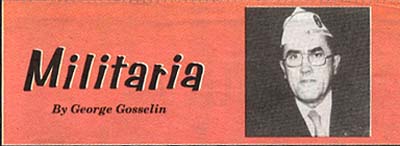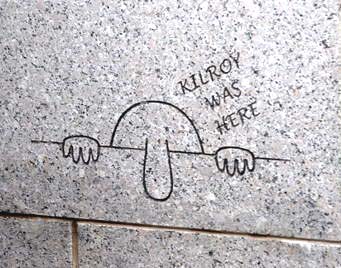By George Gosselin
'Militaria'
Senior Beacon, September 2007, Page 56

Veterans of World War II are very familiar with the phrase, "Kilroy Was Here." It was found written just about everywhere on walls, signs, pieces of equipment from Berlin to Tokyo, Burma to Bastogne. It was always re-assuring to see it because no matter how hard the duty, or the battle, some American trooper took the time to find some humor in grave circumstances. Thank God American fighting men .were like that; it helped to win the war.
Men such as Bill Mauldin and Ernie Pyle did as much to motivate men as their officers did.

[Photo not in original article]
I've spoken to Korean War veterans who were familiar with Kilroy, he was there for them also, and for the troops in Vietnam. Here's how it started: Kilroy was a 46 year old shipyard worker hailing from Halifax, Massachusetts, and during the war he worked as a checker at the Quincy, Mass., shipyard. As a checker his job was to go around and inspect the number of rivets inserted by the workers. Riveters were on piece work and got paid by the rivet. Kilroy would count the block of rivets and put a check mark in chalk so the rivet wouldn't be counted twice. When he was off duty some riveters would erase the chalk mark. Later on another checker would come through and count the rivets a second time, resulting in double pay for the riveters.
One day Kilroy's boss called him into his office. The boss was upset about all the wages being paid to riveters and asked Kilroy to investigate. Kilroy figured it out but the tight places he had to crawl through wouldn't allow a paint can and brush. He decided to stick with the chalk and continued to put his check mark on each site he inspected, but now he added "Kilroy Was Here" in king-size letters next to the check. Once he did that the riveters stopped wiping away his marks.
Ordinarily the rivets and chalk marks would have been covered with paint but with a war on ships were leaving the Quincy Shipyard so fast there wasn't time to paint them. As a result, Kilroy's inspection marks were seen by the thousands of servicemen who boarded the troopships that the Yard was producing. Kilroy's message got a chuckle from apprehensive soldiers on their way to war. Consequently, they liked it enough to spread it all over Europe and the Pacific. Along the way someone added a sketch of a G.I. Joe with the long nose looming over a fence, proving again that Americans have a sense of humor that an enemy can never, never comprehend.'
